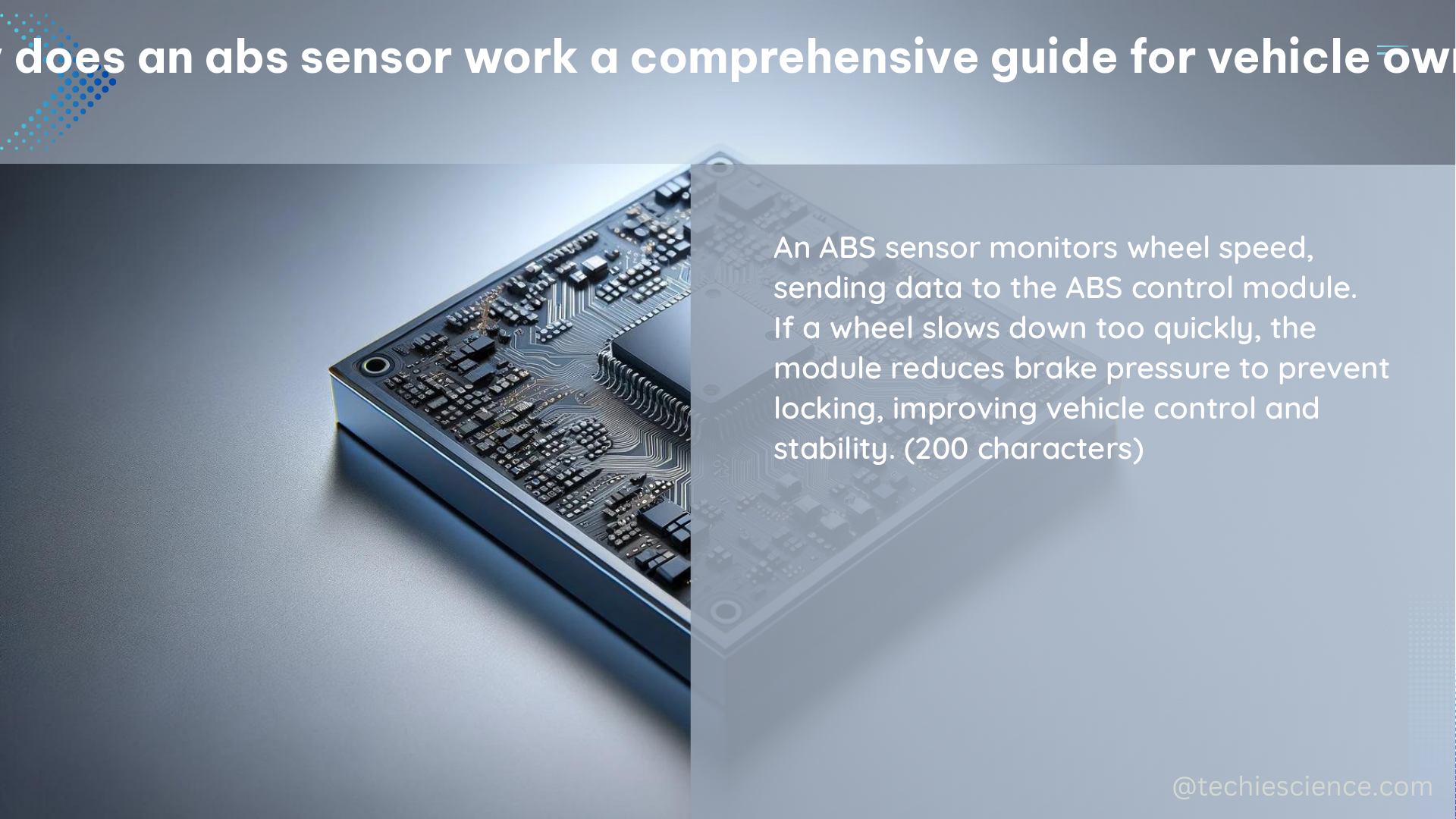An ABS sensor, also known as a wheel speed sensor, is a critical component of a vehicle’s anti-lock braking system (ABS) and other safety features like traction control and stability control. It monitors the wheel’s speed and rotation to optimize brake and traction control via the ABS. The sensor consists of two main components: a reluctor wheel or tone ring positioned on the axle, which rotates with the wheel, and a magnetic or Hall effect sensor that sends data to the ABS control module.
Understanding the ABS Sensor Mechanism
The ABS sensor works by generating an AC voltage when a toothed tone ring or reluctor passes by the sensor. The ABS module monitors the change in frequency and amplitude as the wheel rotates. This data is used to detect wheel slip and prevent the wheels from locking up during heavy braking, improving the vehicle’s stability and control.
Sensor Output Characteristics
The sensor outputs an Alternative Current (AC) voltage that is generated when a toothed tone ring or reluctor passes by the sensor. The typical reading for a passive wheel speed sensor is between 1,000 and 2,500 ohms, which is a normal range for all passive sensors. The specification for active sensors is also between 1,000 and 2,500 ohms.
To test the sensor output, you can use a multimeter set to AC voltage. Spin the wheel by hand, and the sensor should produce between 0.5 to 1 volt of AC current. The faster the wheel is spun, the more voltage will be produced.
Sensor Signal Characteristics
Some vehicles will send a DC voltage to the sensor through the ground wire, and the sensor signal will ride up on the DC signal. This is done so that the sensor can be tested by the ABS system without the vehicle moving. These types of vehicles will set Wheel Speed Sensor (WSS) codes the moment the key is turned on.
Diagnosing ABS Sensor Faults

A faulty ABS sensor can impact a number of important braking functions and will exhibit some obvious warning signs, including:
- ABS light illumination
- Traction control light illumination
- Reduced stopping power under heavy braking
- Less stability under wet or icy conditions
To identify the source of any sensor faults, consider the following steps:
- Connect a diagnostic tool and record any fault codes.
- Check the live data parameters for the ABS sensor.
- Use a multimeter and oscilloscope to check the supply voltages and signals at the sensor.
- Inspect the connectors and wiring of the sensors to ensure they are correctly positioned and secured, and for signs of damage or contamination.
- Check the sensor and impulse ring for damage. If dirt is present, clean the contact surface using a wire brush.
Common fault codes and causes include:
| Fault Code | Description |
|---|---|
| C0060 | Left front ABS solenoid 1 circuit malfunction |
| C0065 | Left front ABS solenoid 2 circuit malfunction |
| C0070 | Right front ABS solenoid circuit malfunction |
| C0075 | Right rear ABS solenoid circuit malfunction |
| C0080 | Left rear ABS solenoid circuit malfunction |
Replacing a Faulty ABS Sensor
When replacing a faulty ABS sensor, it is important to follow best practices to ensure proper installation and function. This includes:
- Loosening the wheel nuts before jacking the car up.
- Removing the wheels and brake pads and discs if necessary.
- Unplugging the sensor.
- Cleaning the area around the sensor.
- Installing the new sensor in reverse order.
- Torque tightening the wheels to the manufacturer’s specification.
- Rechecking for any new fault codes.
By following these steps, you can ensure that the new ABS sensor is properly installed and functioning correctly, restoring the vehicle’s safety systems to their full capability.
Conclusion
In summary, an ABS sensor is a crucial component of a vehicle’s safety systems, and understanding how it works and how to diagnose and replace a faulty sensor is essential for any vehicle owner or technician. By following the comprehensive guide provided in this article, you can ensure that your vehicle’s ABS system is operating at its best, providing you with the safety and stability you need on the road.
References:
– How to read OBDII live data: A mechanic guide
– Wheel Speed Sensor Diagnostics for Meters and Scopes
– Making Sense of Your Sensors: ABS Sensor

The lambdageeks.com Core SME Team is a group of experienced subject matter experts from diverse scientific and technical fields including Physics, Chemistry, Technology,Electronics & Electrical Engineering, Automotive, Mechanical Engineering. Our team collaborates to create high-quality, well-researched articles on a wide range of science and technology topics for the lambdageeks.com website.
All Our Senior SME are having more than 7 Years of experience in the respective fields . They are either Working Industry Professionals or assocaited With different Universities. Refer Our Authors Page to get to know About our Core SMEs.